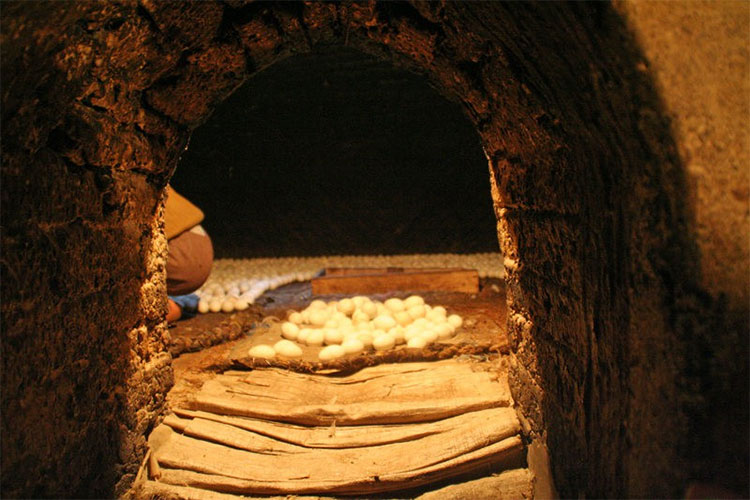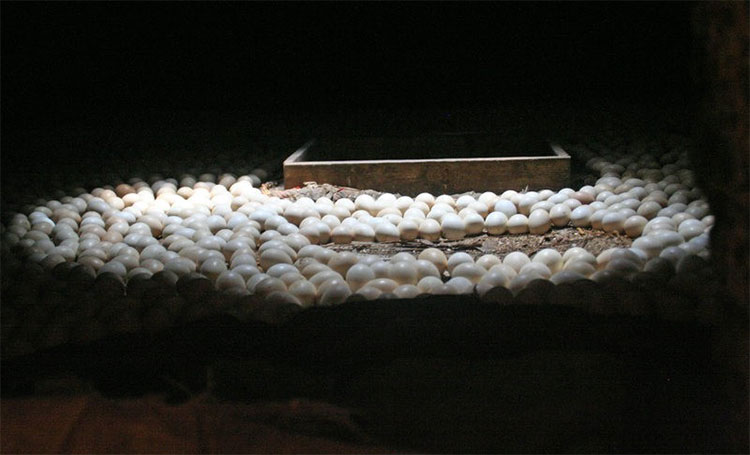Not the pyramid, this is the most valuable work that the ancient Egyptians left for posterity
Speaking of Egypt, everyone thinks of mummies, pyramids and stories of gods. But in fact, the Egyptians also possess extremely valuable inventions and architectural works that many people do not know.
As when the insectologist studied the French René Antoine Ferchault de Réaumur (1683 - 1757), when he first visited Cairo, he praised the Egyptian incubator as a valuable architectural masterpiece over the Great Pyramid of Giza.

Ancient Egyptian incubator.
Ancient Egyptian incubator is a 2-storey architectural style, consisting of 5 pairs of symmetrical chambers separated by a corridor in the middle. The lower floor is used to arrange fertilized poultry eggs, which can hold up to 4500 fruits. The upper floor burns the fire, ensuring that the radiating temperature is always equal to the heat under the mother's belly.
Interestingly, until now, 2000 years have passed and science and technology intervenes in everything, ancient Egyptian incubators are still used in both the Nile Delta and rural areas throughout Europe.
Color magic with the Western world is an early age
It can be said that since Alexander the Great's invasion of Egypt (356 –323 BC), the Western perception had a great expansion.
At first, they were amazed at the huge structures such as palaces, temples, pyramids. Next, they overpowered deep mathematical understanding, the art of making strange papyrus. Many profound figures have taken the road to Egypt to witness, including Aristotle (384-322 BC), the most famous Greek philosopher.

2000 years passed, this work is still valid until now.
But what makes Aristotle "gaping at its mouth" is not the massive architecture, but the spectacle of thousands of chickens massively coming out from . piles of dung in a furnace.
Back home, Aristotle wrote that in Egypt, "eggs hatch into chicks". Everyone was surprised to believe it. Unfortunately, who doubts a great sage like Aristotle?
After Aristotle for about 200 years, Diodorus Siculus (90-30 BC), the famous Roman historian followed."Most amazing is how the Egyptians raise the number of children. They don't hatch their eggs naturally, we all know it and use our own hands, with a special technique, created. many countless " - he notes.
Chicks do not come out from the pile, but they still need to hatch
With common sense today, no one is fooled by the story of egg hatching or coming out of the dung. However, Aristotle did not lie. He just didn't understand the principle of operation of the Egyptian incubator.
Basically, the kiln that Aristotle once saw is a 2-storey structure covered with mud. Considering the cross-section, it consists of an empty corridor and a pair of symmetrical 2-storey chambers.

Basic architecture of ancient Egyptian incubator.
An incubator can have up to 5 pairs of rooms, enough space to fit up to 4500 eggs. The roof of these 5 chambers has a spire-shaped, open-top shape for convenient smoke exit. After putting eggs in the lower floor, people caught fire on the upper floor, carefully watching and keeping heat.
Located in Africa, Egypt is also hot and poor in trees like any other Black Continent country. So instead of struggling to find firewood, people collect dried manure as fuel. Although Aristotle mistook that the chicks came from the dung, they did, thanks to feces, hatched.
Appeared late because chickens are not native animals

Chickens are not among the food in Egypt, until the 4th century BC
Compared to long-standing architectural masterpieces like pyramids, incubators appear quite late. Originally, chickens were not native African animals but from Asia. About 10,000 years ago, they began to be domesticated, fed as food. The widespread trade story brought them out of their cradle, finally arriving in Egypt.
In Egypt, it was only during the Greek period (332-30 BC) that chicken was part of the menu. With superior intelligence, people soon understand the principle of hatching and applying in practice.
Do not want to be "learned" by enemies, the Egyptians absolutely hide their skills. So both Aristotle and Diodorus Siculus are ambiguous, eventually mistaking that Egyptians have magic to make their eggs hatch.
Still used in the modern world
Until 1750, when Réaumur traveled to Egypt, determined to thoroughly explore the technique of hatching instead of this miraculous mother and mother, the new Western world broke. He realized that in addition to keeping and stabilizing the heat appropriately, the incubator's supervisor had to occasionally return to the egg, just like a mother hen took the beak herself.
In nature, chickens feel the time when eggs are about to hatch with instinct. At this time, the eggs were self-sufficient in heat, no need for mother chickens to lie in the nest. The impression is that in the incubator, people also understand the instincts of the mother chicken. They just need to pick up the eggs, press their eyes and feel the heat, guessing they are about to have their shells cut to reduce heat.

An ancient Egyptian incubator can hatch thousands of chicks
After collecting all technical information, Réaumur immediately returned to France, installed the furnace and tested it. Unfortunately, until his death in 1757, he had never succeeded. However, the West did not give up. By 1890, they had their first hatchery in Canada, due to a farmer's light burning tips by Lyman Byce .
Very quickly, Byce's method of using charcoal is widely available. After him, there are more and more modern innovations. I thought that when the electric incubators spread all over the place, no one would use an old-style incubator. Yet in 2006, when the European Food and Agriculture Organization (FAO) began mapping chicken farms in rural areas, they were surprised to find that many farm owners still had to both, not just an incubator.

Today, Egyptian incubators use modern fuel.
Instead of using a temperature thermometer, modern people also prefer to feel their own incubator heat with their hands and eggs about to hatch with their eyes.
Moving to Egypt, FAO was even more surprised. In the Nile Delta there are still about 200 ancient-style incubators. They are no different from 2000 years ago, just no longer using manure to burn but using modern fuels (gasoline or oil).
- Find out how the Egyptians moved giant stones to 800km to build pyramids
- How was the Egyptian pyramid built?
- 2 ancient tombs of 4,200 years worshiping priests in Egypt
- 6 things we do not know about the people of ancient Egypt
- New discovery of ancient Egyptian tools using the construction of the Giza Pyramid
- Surprise with the evidence that ancient Egyptians used light bulbs to light
- Cruel punishments of ancient Egyptians
- Explore the tunnel in Cheops pyramid
- Watch the Pyramid guard machine to see how smart the ancient Egyptians were
- Discovering the first pyramid of humanity, building 1000 years before the Egyptian Pyramid
- Found a large Egyptian boat near the pyramid
- 10 interesting inventions of ancient Egyptians (II)
 'Fine laughs' - Scary and painful torture in ancient times
'Fine laughs' - Scary and painful torture in ancient times The sequence of numbers 142857 of the Egyptian pyramids is known as the strangest number in the world - Why?
The sequence of numbers 142857 of the Egyptian pyramids is known as the strangest number in the world - Why? History of the iron
History of the iron What is alum?
What is alum?